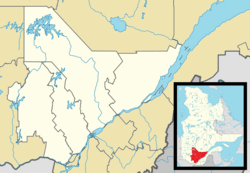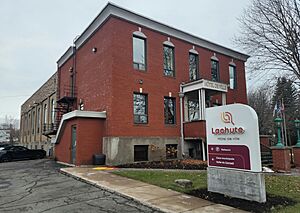Lachute facts for kids
Quick facts for kids
Lachute
|
|
|---|---|
|
City
|
|
 |
|

Location within Argenteuil RCM
|
|
| Country | Canada |
| Province | Quebec |
| Region | Laurentides |
| RCM | Argenteuil |
| Settled | 1753 |
| Constituted | April 30, 1966 |
| Area | |
| • City | 112.80 km2 (43.55 sq mi) |
| • Land | 108.66 km2 (41.95 sq mi) |
| • Urban | 9.59 km2 (3.70 sq mi) |
| Population
(2021)
|
|
| • City | 14,100 |
| • Density | 129.8/km2 (336/sq mi) |
| • Urban | 11,221 |
| • Urban density | 1,169.8/km2 (3,030/sq mi) |
| • Pop 2016–2021 | |
| • Dwellings | 6,862 |
| Time zone | UTC−5 (EST) |
| • Summer (DST) | UTC−4 (EDT) |
| Postal code(s) |
J8H
|
| Area code(s) | 450 and 579 |
| Highways |
|
Lachute (pronounced "la-shoot") is a lively town in southwest Quebec, Canada. It's about 82 kilometers (51 miles) northwest of Montreal. The town sits on the Rivière du Nord, which flows into the Ottawa River. Lachute is also west of the Mirabel International Airport.
You can easily reach Lachute by car, as it's located on Autoroute 50. Several provincial highways, like Route 148 and Route 158, also meet here. Lachute is the main town for the Argenteuil Regional County Municipality. It even has its own local airport, the Lachute Airport. The town's main businesses include paper mills, lumber production, and various factories. More than 14,000 people call Lachute home.
Contents
Lachute's History: From Falls to Town
In the 1600s, the name "La Chute" referred to a waterfall on the North River. This waterfall was about 24 kilometers (15 miles) upstream from where the North River joins the Ottawa River. In 1753, Antoine Brunet was the first French-speaking person to settle in Lachute, though only for a short time.
Early Settlers and Growth
In 1796, Jedediah Lane from Jericho, Vermont, bought a lot of land in the area. That same year, Hezekiah Clark and his family, also from Jericho, settled near the falls. They were soon joined by Loyalists who were leaving the American Revolution. By 1798, the settlement, then called "The Chute," had five families.
The village quickly grew. By 1803, about 30 families lived on both sides of the North River. By 1810, Lachute had 83 families, including 211 children ready for school. A mill was built at the falls in 1804, and the first general store opened in 1813. In 1814, Sir John Johnson bought a large part of the Argenteuil Seigneury. He built a sawmill and gave land for churches, which helped attract more settlers. Thomas Barron became Lachute's first judge in 1825, and later its first mayor. The Lachute post office opened in 1835.
Modern Development and Changes
From 1870 to 1880, Lachute experienced another period of growth. A railway connecting Montreal and Ottawa was built right through the town. New industries also started up, including a wool mill and a paper mill.
In 1885, Lachute officially became a town with about 1,300 residents. The Lachute high school was also founded that year. In 1901, electricity arrived in the town.
In 1966, Lachute and the nearby Village of Ayersville joined together to form the Cité de Lachute. Later, in 1971, a part of the Saint-Jérusalem Parish was added to Lachute during the building of Montréal-Mirabel International Airport. In 1981, the Cité de Lachute became the Ville de Lachute. In 2000, Lachute grew even more when about 10 square kilometers (3.9 square miles) of Mirabel's land became part of the town. In 2002, the local police service was taken over by the Sûreté du Québec, Quebec's provincial police force.
The Famous Expo Lachute Fair
The Expo Lachute Fair is a very old and popular event. It's the oldest fair in Quebec and the second-oldest in all of Canada! It has been running since 1825. In 1917, the Argenteuil Agricultural Society bought land in Lachute to host the fair permanently. They built a grandstand and a track, and later added barns for cattle and horses.
The fair used to be held in the fall but changed to a spring fair in 1925 to focus on livestock shows. The fair wasn't always in Lachute. It started in St. Andrews, a busy business center at the time. Today, the Expo Lachute Fair is still very popular. An annual agriculture fair takes place in July, and a Fall Derby is held in September. The fairgrounds are also used for many other local events throughout the year.
Lachute's Population and People
Lachute has seen its population grow steadily over the years. In the 2021 Census, Lachute had 14,100 people living there. This was a 9.6% increase from its population in 2016. The town covers a land area of about 108.66 square kilometers (41.95 square miles).
Most people in Lachute speak French as their first language. In 2011, about 87% of the population spoke French. English is the second most common language, spoken by about 10.65% of the people. A small number of residents speak both French and English, or other languages.
Lachute's Climate
Lachute experiences a typical Canadian climate with warm summers and cold, snowy winters.
| Climate data for Lachute (1981–2010) | |||||||||||||
|---|---|---|---|---|---|---|---|---|---|---|---|---|---|
| Month | Jan | Feb | Mar | Apr | May | Jun | Jul | Aug | Sep | Oct | Nov | Dec | Year |
| Record high °C (°F) | 10.5 (50.9) |
12.5 (54.5) |
20.5 (68.9) |
31 (88) |
32.2 (90.0) |
35 (95) |
34.4 (93.9) |
35.5 (95.9) |
32.5 (90.5) |
27.2 (81.0) |
20 (68) |
13.5 (56.3) |
35.5 (95.9) |
| Mean daily maximum °C (°F) | −6.1 (21.0) |
−3.5 (25.7) |
2.3 (36.1) |
11.3 (52.3) |
18.8 (65.8) |
23.8 (74.8) |
26 (79) |
24.9 (76.8) |
20.0 (68.0) |
12.4 (54.3) |
4.9 (40.8) |
−2.5 (27.5) |
11.0 (51.8) |
| Daily mean °C (°F) | −10.7 (12.7) |
−8.6 (16.5) |
−2.6 (27.3) |
6.0 (42.8) |
12.9 (55.2) |
18.0 (64.4) |
20.4 (68.7) |
19.3 (66.7) |
14.7 (58.5) |
7.7 (45.9) |
1.3 (34.3) |
−6.5 (20.3) |
6.0 (42.8) |
| Mean daily minimum °C (°F) | −15.4 (4.3) |
−13.6 (7.5) |
−7.5 (18.5) |
0.7 (33.3) |
6.9 (44.4) |
12.2 (54.0) |
14.7 (58.5) |
13.7 (56.7) |
9.2 (48.6) |
3.1 (37.6) |
−2.4 (27.7) |
−10.4 (13.3) |
0.9 (33.6) |
| Record low °C (°F) | −37 (−35) |
−35 (−31) |
−30.5 (−22.9) |
−15 (5) |
−6.7 (19.9) |
−1.5 (29.3) |
3.5 (38.3) |
0 (32) |
−5 (23) |
−8.9 (16.0) |
−20.6 (−5.1) |
−34.5 (−30.1) |
−37 (−35) |
| Average precipitation mm (inches) | 91.2 (3.59) |
69.7 (2.74) |
72.9 (2.87) |
87.5 (3.44) |
96.4 (3.80) |
115.0 (4.53) |
100.2 (3.94) |
103.6 (4.08) |
107.6 (4.24) |
110.1 (4.33) |
106.3 (4.19) |
90.1 (3.55) |
1,150.5 (45.30) |
| Source: Environment Canada | |||||||||||||
Education in Lachute
Lachute has schools that teach in both French and English.
French-language Schools
The Commission scolaire de la Rivière-du-Nord manages these public schools:
- École l'Oasis
- École Saint-Alexandre
- École Saint-Julien
- École Polyvalente Lavigne
English-language Schools
The Sir Wilfrid Laurier School Board operates these public schools:
- Laurentian Elementary School
- Laurentian Regional High School
Famous People from Lachute
Many notable individuals have connections to Lachute:
- John Lavis
- Salem Bland: A Methodist religious leader and a key figure in the Social Gospel movement.
- Kevin Lowe: A former NHL defenseman and currently a vice-chairman for the Edmonton Oilers.
- Jim Watson: A former politician who served as a Member of Provincial Parliament (MPP) for Ottawa West—Nepean. He was also a Minister of Municipal Affairs and Housing and a former Mayor of Ottawa, Ontario.
- Pierre Pagé: A former coach for several NHL hockey teams, including Calgary and Quebec. He is currently the head coach of Eisbären Berlin in Germany.
- Thain Wendell MacDowell: A brave soldier who received the Victoria Cross in 1917 for his actions at Vimy Ridge, France.
- Bob Paulson: The 23rd Commissioner of the RCMP (Royal Canadian Mounted Police). He also commanded the National Security Criminal Investigations Unit.
Media in Lachute
- CJLA-FM (Planète Lov 104,9): This is a radio station that plays popular adult contemporary music.
See also
 In Spanish: Lachute para niños
In Spanish: Lachute para niños




